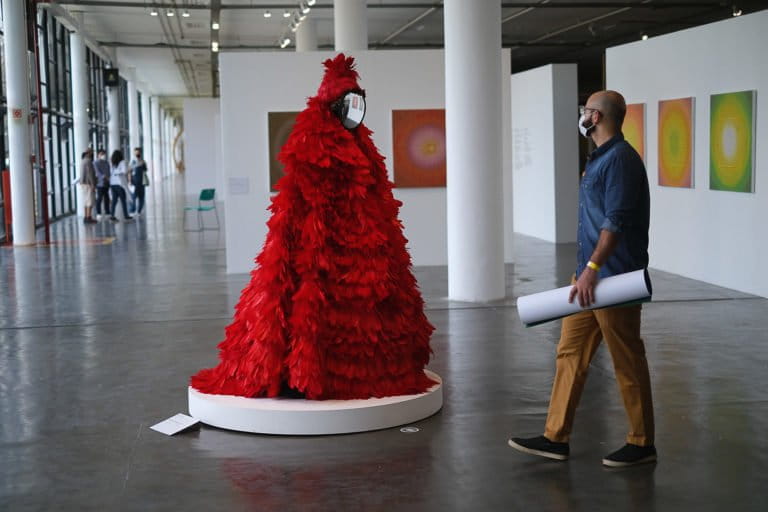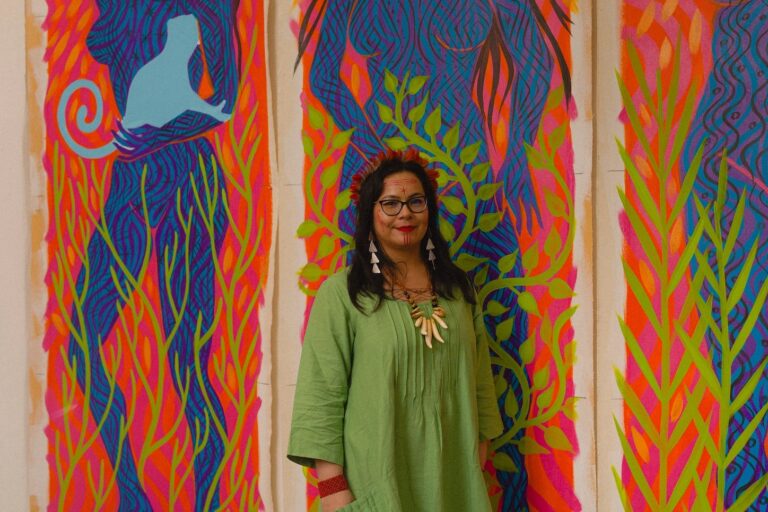- In an interview with Mongabay, artist, educator and political activist Daiara Tukano talks about the pathways by which art inspires critical thinking for the general public and helps in the fight for Indigenous rights.
- Daiara Tukano says people need to understand about the immense diversity among Indigenous peoples to dispel with the long-held archetype of the Brazilian “Indian” and recognize that they’re not only native to the Amazon.
- Given the gradual changes in attitude happening at some museums with regard to Indigenous artistic and linguistic expression, Daiara Tukano says the space must be occupied “through the front door,” while being conscious of potential traps laid by power games.
- “What is driving our fight isn’t a cry of rage, but rather a song of love,” she says. “Happiness seems like a far-off dream when you’re born into this genocidal system. But it’s because of these [happy] moments that our people are still standing.”
Whether you’re looking at her giant paintings of Indigenous women creators or having a chat before the interview, Daiara Tukano always transmits her power, her well-honed critical viewpoint and excellent sense of humor.
Daiara Tukano, who is also a political activist, educator and communicator, hails from the Yepá Mahsã people, also known as the Tukano, who are native to the Upper Rio Negro region in Brazil’s Amazonas state. She visited São Paulo in February for the opening of her first solo exhibition, “Amõ Numiã,” held on a sunny Saturday morning at a packed gallery in the city. Her first remarks regarding what she took away from the event left us reeling: “I thought it was incredible that there were so many children there, and even three dogs.”
In this exclusive Mongabay interview, the artist speaks frankly about museums still run with a colonial air, tells of the importance of seeing Indigenous women in government, and quotes U.S. drag queen RuPaul when she speaks about what moves her to create. The interview has been translated from Portuguese and lightly edited for length and clarity.
Mongabay: Does art help drive the Indigenous fight? Does it reach places that information from organizations like nonprofits doesn’t, for example?
Daiara Tukano: Without a doubt, the work of Indigenous musicians, painters and influencers reaches an audience far beyond those already following the issues being debated in Congress. Our artistic expression and political engagement are fundamental to our fight and to involving more people all the time.
On this year’s ENEM [the Brazilian standardized university entrance exam], there was a question about traditional peoples and we got a ton of feedback from students saying they had referenced our works. Many told me they had gotten to know my work at Cura [an urban art circuit in the city of Belo Horizonte, Minas Gerais state]. These agendas would take much longer to reach these teenagers by other means — and maybe they never would. It’s an agenda that today occupies a space inside schools, in the media, in music … like the Guarani-Kaiowá rappers [Brô MCs] who played at Rock in Rio.
This type of visibility is very important, and not just for political reasons. It’s great to see that people really appreciate these works artistically.
Mongabay: Could this broader scope help finance projects supporting Indigenous issues or is that not the focus?
Daiara Tukano: The most we can hope for with our art is to have an impact. The more people we reach, the more politically evolved people there will be to vote for those who defend our rights.
We want Brazilians to understand that protecting Indigenous cultures and territories means defending a wealth that belongs to all of us, not just some of us. Voters who don’t know about the violence committed against Indigenous people elect people who want illegal mining in Indigenous territories.
We are focused on making people aware and showing that there are many different Indigenous people trying to survive throughout Brazil. Of course, if in the middle of all this we manage to get more investments to develop fair social policy, that would be great too.

Mongabay: So the next step is to understand this diversity among the original peoples of Brazil?
Daiara Tukano: Absolutely. Stereotypes must be laid to rest together with the attempt to promote a homogenized “Indian image.” We are more than 305 peoples with different demands. Some people think that Indigenous people only live in the Amazon. We are everywhere. There are terrible situations going on in other regions as well, like the repossession [of Indigenous lands] in the state of Mato Grosso do Sul.
The big challenge in art isn’t just to show this diversity, but also to make it interesting to the general public. Diplomatic relations must be established with white people, with museums and with our own communities so they understand the importance of our presence in these places. And then move forward so we can discuss how we will occupy these spaces, always listening to the most educated people within each group, to problematize what we call art, to discuss our cultural fortification, the reparation … So, things can get pretty tricky, you know? But at the end of the day, the sky is our limit [laughs]. We just can’t get caught in any traps.

Mongabay: What traps?
Daiara Tukano: Power games, for example. Indigenous people and our art are not trends. Because the “Indian theme” was already a trend back in the day when José de Alencar, the Modernists and the Tropicalists were producing work.
It’s way past time to take a deep look at this theme, because the art world usually wears Western and European glasses. There is a gap when considering the arts originating outside the European basin which, due to these colonizing and civilizing relationships, are treated as “lesser art.” Many museums remain deeply colonial.
But today we have a generation that fought and continues to fight for a place inside these spaces. And it wasn’t because these institutions wanted to open their doors first. It was because we made them do it. They will no longer put us in a display case, in a tiny room. We will enter through the front door and you will have to make yourselves understand that this space belongs to us as well. We are the only ones with the autonomy to represent our image. Never again will it be about us if we’re not involved.
Mongabay: Do museums continue to have this attitude? Have you seen any change?
Daiara Tukano: A lot of that still goes on, at museums both inside and outside Brazil. But there are discussions underway all over the world about art produced by Indigenous people who survived genocidal colonization and are now “dotting their ‘i’s and crossing their ‘t’s” because no one can take this relationship based on power any more … it’s tacky and rude.
I have seen change. At the Museum of the Portuguese Language [in São Paulo], I am curator of the first exhibition ever on Indigenous tongues [“Nhe’ẽ Porã: Memory and Transformation”]. That particular institution understands its educational role and focuses on reparation, memory and justice.

Mongabay: In your show at the Millan Gallery, you evoke the Amõ Numiã, who in the Tukano tradition were the first two women on Earth, to reflect on “the destruction provoked by a misogynist, racist, colonial and predatory culture.” Were you moved to do this because of rage or anger?
Daiara Tukano: No. What inspires me is love. I really liked it when RuPaul said that there are really only two emotions in the world: love and fear. All the good emotions are the result of love, and the bad ones are the result of fear, including anger. We talk a lot about transgenerational trauma, an element that is unfortunately part of how our identities are formed. We are profoundly marked by trauma and continue to live within a genocidal context until the present day. So sadness and anger are emotions that we are familiar with from the time we are small children. Still, what drives our struggle is not a cry of anger, but a song of love.
In the Women’s March, I see prayers and songs that tell of the creation, of love for the Earth, for the rivers, for the grandchildren who have not yet been born, for the grandparents who fought to feed us and to win us the political right to be citizens. If it weren’t for this love, we wouldn’t be here.
I’ve already gotten pressure to draw tougher things, but if I were to do that, I wouldn’t be able to take it because I’m here, struggling to stay alive. Life should be lived in the best manner possible. Happiness seems like a far-off dream when you’re born inside this genocidal system. But happiness is composed of small and rare moments. And it’s because of these moments that our people are still standing.

Mongabay: Was seeing Indigenous activist Sonia Guajajara elected minister, and the creation of the Ministry of Indigenous Peoples, one of these moments?
Daiara Tukano: That was a victory. I had already shed tears of joy when Joenia Wapichana was elected [to Congress in 2019], which was a historic “premiere” for the Indigenous movement in politics that culminated with Sonia and Célia Xakriabá.
The ministry is a victory for the Indigenous movement. It brings the sensation that the state will have fewer arguments for remaining silent in the face of genocide. I feel like it’s a relief, but I know it won’t be simple.
We have to make sure the media provides proper coverage so that everyone knows what is happening to Indigenous people, so that everyone can be involved. Because we will continue to shake our maracas and lift our arrows — which are not to attack, but to make people aware, so that we can all embrace this Earth because we are all her children.
Daiara Tukano’s show ran at the Millan Gallery (R. Fradique Coutinho, 1360, São Paulo, SP) until March 11.
Banner image: Visual artist Daiara Tukano with her work at the Millan Gallery in São Paulo, Brazil. Image courtesy of Ana Pigosso/Millan Gallery.
This story was reported by Mongabay’s Brazil team and first published here on our Brazil site on Feb. 27, 2023.
See more of our Brazil-based coverage like the below, here:
Brazilian 3-banded armadillo benefits from community conservation in Bahia
This story first appeared on Mongabay
South Africa Today – Environment
This article is licensed under a Creative Commons Attribution-NoDerivatives 4.0 International License.
You may republish this article, so long as you credit the authors and Mongabay, and do not change the text. Please include a link back to the original article.












